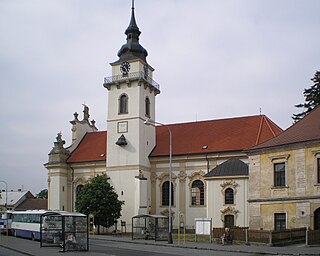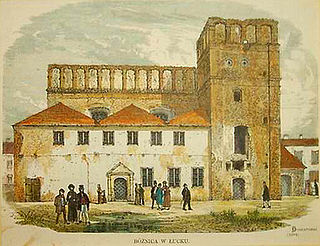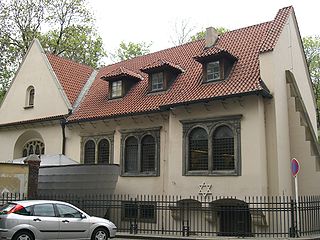
Kazimierz is a historical district of Kraków and Kraków Old Town, Poland. From its inception in the 14th century to the early 19th century, Kazimierz was an independent city, a royal city of the Crown of the Polish Kingdom, located south of the Old Town of Kraków, separated from it by a branch of the Vistula river. For many centuries, Kazimierz was a place where ethnic Polish and Jewish cultures coexisted and intermingled. The northeastern part of the district was historically Jewish. In 1941, the Jews of Kraków were forcibly relocated by the German occupying forces into the Krakow ghetto just across the river in Podgórze, and most did not survive the war. Today, Kazimierz is one of the major tourist attractions of Krakow and an important center of cultural life of the city.

Turnov is a town in Semily District in the Liberec Region of the Czech Republic. It has about 14,000 inhabitants. It is a traditional centre for gemstone polishing, glass craftsmanship and arts. The historic town centre is well preserved and is protected by law as an urban monument zone.

The Old New Synagogue, also called the Altneuschul, situated in Josefov, Prague, is Europe's oldest active synagogue. It is also the oldest surviving medieval synagogue of twin-nave design.

Ivančice is a town in Brno-Country District in the South Moravian Region of the Czech Republic. It has about 9,900 inhabitants. The historic town centre is well preserved and is protected by law as an urban monument zone.

Heřmanův Městec is a town in Chrudim District in the Pardubice Region of the Czech Republic. It has about 4,900 inhabitants. The historic town centre with the castle complex is well preserved and is protected by law as an urban monument zone.

The history of the Jews in Prague, the capital of today's Czech Republic, relates to one of Europe's oldest recorded and most well-known Jewish communities, first mentioned by the Sephardi-Jewish traveller Ibrahim ibn Yaqub in 965 CE. Since then, the community has existed continuously, despite various pogroms and expulsions, the Holocaust, and subsequent antisemitic persecution by the Czech Communist regime in the 20th century.

The Old Jewish Cemetery is a Jewish cemetery in Prague, Czech Republic, which is one of the largest of its kind in Europe and one of the most important Jewish historical monuments in Prague. It served its purpose from the first half of the 15th century until 1786. Renowned personalities of the local Jewish community were buried here; among them rabbi Jehuda Liva ben Becalel – Maharal, businessman Mordecai Meisel (1528–1601), historian David Gans and rabbi David Oppenheim (1664–1736). Today the cemetery is administered by the Jewish Museum in Prague.

The Frankfurter Judengasse was the Jewish ghetto of Frankfurt and one of the earliest ghettos in Germany. It existed from 1462 until 1811 and was home to Germany's largest Jewish community in early modern times.

The Remah Synagogue is a 16th-century Jewish synagogue and the smallest of all historic synagogues in the Kazimierz district of Kraków, Poland. The synagogue is named after Rabbi Moses Isserles (c.1525–1572), known by the Hebrew acronym ReMA who's famed for writing a collection of commentaries and additions that complement Rabbi Yosef Karo's Shulchan Aruch, with Ashkenazi traditions and customs. It is currently one of two active synagogues in the city.

Zamość Synagogue is a UNESCO-protected Renaissance synagogue built between 1610 and 1618 in Zamość, southeastern Poland. Erected during the times of the Polish–Lithuanian Commonwealth, it functioned as a place of worship for Polish Jews until World War II, when the Nazis turned the interior into a carpenters' workshop. The structure was spared from destruction and in 1992 it became a UNESCO World Heritage Site alongside the Old City of Zamość.

Maisel Synagogue is one of the historical monuments of the former Prague Jewish quarter. It was built at the end of the 16th century which is considered to be the golden age of the ghetto. Since then its appearance has changed several times, its actual style is neo-gothic. Nowadays the synagogue belongs to the Jewish Community of Prague and is administered by the Jewish Museum in Prague as a part of its expositions.

Kupa Synagogue is a 17th-century synagogue in Kraków, Poland. It is located in the former Jewish quarter of Kazimierz developed from a neighborhood earmarked in 1495 by King John I Albert for the Jewish community, which has been transferred from the budding Old Town. Kupa Synagogue serves Kraków's Jewish community as one of the venues for religious ceremonies and cultural festivals, notably the annual Jewish Culture Festival in Kraków.

In the early modern era, European Jews were confined to ghettos and placed under strict regulations as well as restrictions in many European cities. The character of ghettos fluctuated over the centuries. In some cases, they comprised a Jewish quarter, the area of a city traditionally inhabited by Jews. In many instances, ghettos were places of terrible poverty and during periods of population growth, ghettos had narrow streets and small, crowded houses. Residents had their own justice system. Around the ghetto stood walls that, during pogroms, were closed from inside to protect the community, but from the outside during Christmas, Pesach, and Easter Week to prevent the Jews from leaving at those times.

The Jewish Museum in Prague is a museum of Jewish heritage in the Czech Republic and one of the most visited museums in Prague. Its collection of Judaica is one of the largest in the world, about 40,000 objects, 100,000 books, and a copious archive of Czech Jewish community histories.

The Smíchov Synagogue is the only functionalist synagogue in Prague; it was reconstructed to this style in 1931. After the World War II, the building was used for secular purposes because the Smíchov Jewish community ceased to exist in the Shoah. In the present, the building is used for an archive of the Jewish Museum in Prague.

The Great Synagogue in Lutsk, Ukraine, is a Renaissance building with a tower. Located in the Jewish quarter, it was the religious, educational and community centre of Lutsk Jews until the invasion of Poland in the Second World War. It was built in 1626 and is a good example of a fortress synagogue. Partially destroyed in 1942, the synagogue was restored in the 1970s. It is now used as a sports club.

The Jewish Quarter of Třebíč is a neighborhood and former ghetto in the town of Třebíč, located in western Moravia, Czech Republic. The Jewish Quarter is situated on the north bank of the River Jihlava and is one of the best preserved Jewish ghettos in Europe. In 2003, together with the nearby Jewish Cemetery and the St. Procopius Basilica in Třebíč, the Jewish Quarter was inscribed on the UNESCO World Heritage List, because of its testimony to the exchange of cultures and values in the region. As of 2013, it is the only Jewish monument outside Israel specifically placed on the World Heritage List.

The Pinkas Synagogue is the second oldest surviving synagogue in Prague. Its origins are connected with the Horowitz family, a renowned Jewish family in Prague. Today, the synagogue is administered by the Jewish Museum in Prague and commemorates about 77,297 Czech Jewish victims of the Shoah.

The Klausen Synagogue is nowadays the largest synagogue in the former Prague Jewish ghetto and the sole example of an early Baroque synagogue in the ghetto. Today the synagogue is administered by the Jewish Museum in Prague.

The Stolpersteine in Prague-Josefov lists the Stolpersteine in the town quarter Josefov of Prague, the former Jewish quarter of the city. Stolpersteine is the German name for stumbling blocks collocated all over Europe by German artist Gunter Demnig. They remember the fate of the Nazi victims being murdered, deported, exiled or driven to suicide.



























